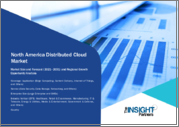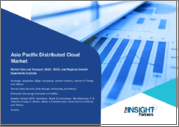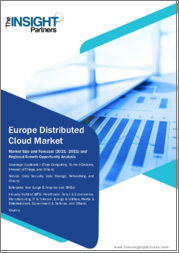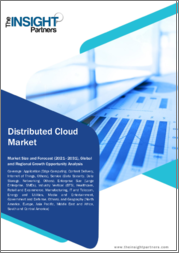
|
시장보고서
상품코드
1715798
분산형 클라우드 시장 : 유형별, 서비스 유형별, 조직 규모별, 용도별, 업계별 - 세계 예측(2025-2030년)Distributed Cloud Market by Type, Service Type, Organization Size, Application, Industry Verticals - Global Forecast 2025-2030 |
||||||
분산형 클라우드 시장은 2024년에는 65억 7,000만 달러에 달하며, 2025년에는 72억 2,000만 달러, CAGR 10.01%로 성장하며, 2030년에는 116억 5,000만 달러에 달할 것으로 예측됩니다.
| 주요 시장 통계 | |
|---|---|
| 기준연도 2024 | 65억 7,000만 달러 |
| 추정연도 2025 | 72억 2,000만 달러 |
| 예측연도 2030 | 116억 5,000만 달러 |
| CAGR(%) | 10.01% |
분산형 클라우드 기술은 기업이 IT 운영을 배포, 관리 및 확장하는 방식에 있으며, 중요한 진화를 의미합니다. 기업이 민첩성과 강력한 데이터 관리의 균형을 맞추기 위해 노력하는 가운데, 기존의 중앙 집중식 모델로는 더 이상 충분하지 않다는 사실이 밝혀지고 있습니다. 오늘날 빠르게 변화하는 디지털 환경에서 분산형 클라우드 프레임워크는 처리와 스토리지를 분산시키고 컴퓨팅 리소스를 데이터가 생성되는 엣지에 더 가깝게 배치하여 성능을 향상시킵니다.
이러한 변화는 인프라뿐만 아니라 서비스 개념화 및 제공 방식에도 패러다임의 전환을 가져오고 있습니다. 기술 혁신가부터 상업적 의사결정권자까지 모든 이해관계자들은 퍼블릭, 프라이빗, 분산 아키텍처를 활용하는 하이브리드 접근 방식을 채택하기로 결정하고 있습니다. 이 미묘한 전략은 지연 시간을 최적화하고, 보안을 강화하며, 전반적인 운영 비용을 절감하는 것을 목표로 합니다.
이처럼 레거시 시스템에서 클라우드 자산이 지역적으로 분산된 통합된 상호운용성이 높은 환경으로 빠르게 변화하고 있습니다. 이에 따라 대기업과 중소기업 모두 디지털 전략을 재평가하고, 현대의 비즈니스 요구에 대응하는 확장성이 높고 지능적인 클라우드 솔루션에 대한 관심이 높아지고 있습니다. 분산형 클라우드는 원활한 사용자 경험과 혁신적 효율성이 특징인 미래로 조직을 이끌고 있습니다.
분산형 클라우드 시장의 변화
최근 동향은 급속한 기술 혁신과 고객 기대치의 진화로 인해 분산형 클라우드의 환경이 크게 변화하고 있음을 보여줍니다. 조직들은 모놀리식 클라우드 배포에서 보다 현지화된 처리 및 저장을 가능하게 하는 유연한 분산형 모델로 전환하는 것을 목격하고 있습니다. 새로운 이용 사례는 대기 시간 단축과 데이터 주권 강화의 중요성을 강조하고 있으며, 이는 엄격한 컴플라이언스 및 보안 프로토콜이 요구되는 분야에서 매우 중요합니다.
또한 경쟁이 치열한 세계 시장의 경제적 압박으로 인해 기업은 IT 인프라를 재구축하고 있습니다. 분산형 클라우드 솔루션의 통합을 통해 기업은 대규모 클라우드 생태계가 제공하는 규모의 이점을 누리면서 로컬 리소스를 활용할 수 있게 되었습니다. 이러한 진화는 단순한 기술적 업그레이드가 아니라 민첩성, 확장성, 탄력성이 지속적인 경쟁 우위의 원동력이 되는 비즈니스 프로세스의 근본적인 변화를 의미합니다.
분산형 아키텍처의 추진은 엣지 컴퓨팅과 첨단 사이버 보안과 같은 관련 분야의 혁신을 촉진하고 있습니다. 분산형 클라우드 모델은 이러한 측면을 결합하여 효율성과 비용 절감의 새로운 길을 열어 궁극적으로 운영 전략을 재정의하고 최종사용자에게 서비스를 제공하는 방식을 변화시킬 수 있습니다.
분산형 클라우드 시장의 주요 세분화 인사이트
시장을 면밀히 분석하면 정교한 세분화 전략을 통해 인사이트를 얻고 동향과 성장 기회를 파악할 수 있으며, 중요한 관점 중 하나는 서비스 유형 관점에서 시장을 조사했으며, IaaS(Infrastructure as a Service), PaaS(Platform as a Service), SaaS(Software as a Service)로 솔루션을 차별화하는 것입니다. Platform as a Service), SaaS(Software as a Service)로 솔루션을 차별화하는 것입니다. 이 분류는 조직이 클라우드 인프라에 요구하는 통합성과 유연성 수준의 차이를 명확히 합니다. 이 분류는 조직이 클라우드 인프라에서 요구하는 통합 및 유연성 수준이 다양하다는 것을 보여줍니다. 또 다른 측면은 서비스 용도에 초점을 맞춘 것으로, 데이터 보안, 데이터 스토리지, 네트워킹 서비스가 디지털 생태계를 강화하고 원활한 연결성을 보장하는 데 중요한 역할을 합니다.
또한 대기업과 중소기업이라는 조직 규모에 따라 인구 통계를 세분화하면 각기 다른 요구 사항과 채택률을 확인할 수 있습니다. 대기업은 일반적으로 견고하고 세계하게 통합된 솔루션에 매력을 느끼는 반면, 중소기업은 최소한의 비용으로 높은 성능을 제공하는 민첩한 플랫폼을 원합니다. 또한 컨텐츠 전송, 엣지 컴퓨팅, 사물인터넷 등 여러 분야에 걸친 용도를 조사하면 그 고민은 더욱 깊어집니다.
마지막으로 산업별 세분화를 통해 은행, 금융 서비스 및 보험, 에너지 및 유틸리티, 정부 및 공공 부문, 헬스케어, IT 및 통신, 제조, 소매 및 소비재 등 각 부문에 맞는 전략을 제시합니다. 이러한 인사이트는 각 산업별 미묘한 수요 촉진요인과 기술 우선순위를 강조함으로써 시장 포지셔닝을 재정의하고, 전략 수립과 정보에 입각한 투자 결정을 지원하는 종합적인 시각을 제공합니다.
목차
제1장 서문
제2장 조사 방법
제3장 개요
제4장 시장 개요
제5장 시장 인사이트
- 시장 역학
- 성장 촉진요인
- 성장 억제요인
- 기회
- 해결해야 할 과제
- 시장 세분화 분석
- Porter’s Five Forces 분석
- PESTLE 분석
- 정치
- 경제
- 사회
- 기술
- 법률
- 환경
제6장 분산형 클라우드 시장 : 유형별
- Infrastructure As A Service(IaaS)
- Platform As A Service(PaaS)
- Software As A Service(SaaS)
제7장 분산형 클라우드 시장 : 서비스 유형별
- 데이터 보안
- 데이터 스토리지
- 네트워킹
제8장 분산형 클라우드 시장 : 조직 규모별
- 대기업
- 중소기업
제9장 분산형 클라우드 시장 : 용도별
- 컨텐츠 배포
- 엣지 컴퓨팅
- 사물인터넷
제10장 분산형 클라우드 시장 : 업계별
- 은행, 금융 서비스, 보험
- 에너지·유틸리티
- 정부 및 공공 부문
- 헬스케어
- IT·통신
- 제조업
- 소매·소비재
제11장 아메리카의 분산형 클라우드 시장
- 아르헨티나
- 브라질
- 캐나다
- 멕시코
- 미국
제12장 아시아태평양의 분산형 클라우드 시장
- 호주
- 중국
- 인도
- 인도네시아
- 일본
- 말레이시아
- 필리핀
- 싱가포르
- 한국
- 대만
- 태국
- 베트남
제13장 유럽, 중동 및 아프리카의 분산형 클라우드 시장
- 덴마크
- 이집트
- 핀란드
- 프랑스
- 독일
- 이스라엘
- 이탈리아
- 네덜란드
- 나이지리아
- 노르웨이
- 폴란드
- 카타르
- 러시아
- 사우디아라비아
- 남아프리카공화국
- 스페인
- 스웨덴
- 스위스
- 튀르키예
- 아랍에미리트
- 영국
제14장 경쟁 구도
- 시장 점유율 분석, 2024
- FPNV 포지셔닝 매트릭스, 2024
- 경쟁 시나리오 분석
- 전략 분석과 제안
기업 리스트
- Accenture PLC
- Akamai Technologies, Inc.
- Alibaba Group Holding Limited
- Amazon Web Services, Inc.
- Cisco Systems, Inc.
- Cloud Sigma AG
- Cloudflare, Inc.
- Cohesity, Inc.
- DELL TECHNOLOGIES INC.
- DigitalOcean Holdings, Inc.
- Equinix, Inc.
- F5, Inc.
- Google LLC by Alphabet Inc.
- HEWLETT PACKARD ENTERPRISE COMPANY
- Huawei Investment & Holding Co., Ltd.
- Infosys Limited
- International Business Machines Corporation
- Kinetica DB, Inc.
- Lumen Technologies, Inc.
- Microsoft Corporation
- Oracle Corporation
- Rackspace Technology, Inc.
- Telefonaktiebolaget LM Ericsson
- Tencent Holding Limited
- Teradata Corporation
- VMware, Inc. by Broadcom, Inc.
- Wind River Systems, Inc.
- Wipro Limited
The Distributed Cloud Market was valued at USD 6.57 billion in 2024 and is projected to grow to USD 7.22 billion in 2025, with a CAGR of 10.01%, reaching USD 11.65 billion by 2030.
| KEY MARKET STATISTICS | |
|---|---|
| Base Year [2024] | USD 6.57 billion |
| Estimated Year [2025] | USD 7.22 billion |
| Forecast Year [2030] | USD 11.65 billion |
| CAGR (%) | 10.01% |
Distributed cloud technology represents a critical evolution in the way businesses deploy, manage, and scale their IT operations. As organizations strive to balance agility with robust data management, they are realizing that traditional centralized models no longer suffice. In today's fast-paced digital environment, distributed cloud frameworks drive performance by decentralizing processing and storage, placing computational resources closer to the edge where data is created.
This transformation brings with it a paradigmatic shift not only in infrastructure but also in how services are conceptualized and delivered. Stakeholders from technology innovators to commercial decision-makers are decidedly embracing a hybrid approach that leverages public, private, and distributed architectures. This nuanced strategy aims to optimize latency, enhance security, and reduce overall operational costs.
The landscape is thus rapidly shifting from legacy systems towards a unified, highly interoperable environment where cloud assets are geographically diversified. As a result, both enterprises and SMEs are reevaluating their digital strategies, with attention increasingly focused on scalable, intelligent cloud solutions tuned to modern business needs. The distributed cloud is propelling organizations into a future characterized by seamless user experiences and transformative efficiencies.
Transformative Shifts in the Distributed Cloud Landscape
Recent trends indicate a marked transformation in the distributed cloud landscape, driven by rapid technological innovation and evolving customer expectations. Organizations are witnessing a shift from monolithic cloud deployments to flexible, decentralized models that allow for more localized processing and storage. Emerging use cases highlight the importance of reduced latency and enhanced data sovereignty, which are pivotal in sectors requiring stringent compliance and security protocols.
In addition, the economic pressures of a competitive global market are prompting enterprises to reimagine their IT infrastructures. The integration of distributed cloud solutions is enabling businesses to tap into localized resources while still enjoying the economies of scale provided by larger cloud ecosystems. This evolution is not merely a technical upgrade; it signifies a fundamental change in business processes, where agility, scalability, and resiliency become the driving factors for sustained competitive advantage.
The push towards decentralized architectures is also fostering innovation in related fields such as edge computing and advanced cybersecurity. By merging these facets, the distributed cloud model opens up new avenues for efficiency and cost reduction, ultimately redefining operational strategies and transforming the way services are delivered to end users.
Key Segmentation Insights in Distributed Cloud Markets
An in-depth analysis of the market reveals insights driven by refined segmentation strategies that illuminate trends and growth opportunities. One critical perspective examines the market from the standpoint of service type, differentiating solutions by Infrastructure as a Service (IaaS), Platform as a Service (PaaS), and Software as a Service (SaaS); this categorization underlines the varying levels of integration and flexibility that organizations demand from their cloud infrastructures. Another dimension focuses on service applications, where offerings span data security, data storage, and networking, each playing a crucial role in fortifying the digital ecosystem and ensuring seamless connectivity.
Further demographic segmentation by organization size, considering large enterprises versus small and medium-sized enterprises, underscores distinct needs and adoption rates. Large corporations are typically drawn to robust, globally integrated solutions while SMEs look for agile platforms that deliver high performance at minimized cost. Moreover, the examination deepens when exploring applications across multiple fronts, including content delivery, edge computing, and the internet of things - each pushing the boundaries of how decentralized resources are deployed for enhanced computational efficiency.
Finally, segmentation by industry verticals reveals tailored strategies for sectors such as banking, financial services, and insurance; energy and utilities; government and public sector; healthcare; IT and telecom; manufacturing; and retail and consumer goods. These insights help redefine market positioning by highlighting nuanced demand drivers and technological priorities unique to each industry, thereby offering a comprehensive view that supports strategic planning and informed investment decisions.
Based on Type, market is studied across Infrastructure As A Service (IaaS), Platform As A Service (PaaS), and Software As A Service (SaaS).
Based on Service Type, market is studied across Data Security, Data Storage, and Networking.
Based on Organization Size, market is studied across Large Enterprises and Small & Medium-Sized Enterprises (SMEs).
Based on Application, market is studied across Content Delivery, Edge Computing, and Internet of Things.
Based on Industry Verticals, market is studied across Banking, Financial Services, & Insurance, Energy & Utilities, Government & Public Sector, Healthcare, IT & Telecom, Manufacturing, and Retail & Consumer Goods.
Key Regional Insights Driving Distributed Cloud Trends
Regional analysis suggests that market dynamics in the distributed cloud domain are as diverse as the regions themselves. Critical observations indicate that trends across the Americas are being driven by rapidly maturing cloud ecosystems and a strong push towards digital transformation amid enterprise modernization programs. In regions encompassing Europe, the Middle East, and Africa, market participants are paying close attention to data localization and stringent regulatory requirements, which are accelerating the deployment of distributed cloud solutions that ensure compliance while boosting performance.
Across Asia-Pacific, a unique set of demands stands out as businesses seek to capitalize on both rapid technological advancements and burgeoning consumer markets. The integration of distributed cloud technology in these regions supports not only faster service delivery but also a more robust handling of localized data processing needs. In summary, these regional insights reflect a rich tapestry of challenges and opportunities, where localized regulations, economic conditions, and consumer expectations drive tailored approaches to implementing distributed cloud architectures. Each region, though distinct in its operational landscape, contributes to a global narrative of innovation, resilience, and a forward-thinking approach to cloud deployment.
Based on Region, market is studied across Americas, Asia-Pacific, and Europe, Middle East & Africa. The Americas is further studied across Argentina, Brazil, Canada, Mexico, and United States. The United States is further studied across California, Florida, Illinois, New York, Ohio, Pennsylvania, Texas, and Washington. The Asia-Pacific is further studied across Australia, China, India, Indonesia, Japan, Malaysia, Philippines, Singapore, South Korea, Taiwan, Thailand, and Vietnam. The Europe, Middle East & Africa is further studied across Denmark, Egypt, Finland, France, Germany, Israel, Italy, Netherlands, Nigeria, Norway, Poland, Qatar, Russia, Saudi Arabia, South Africa, Spain, Sweden, Switzerland, Turkey, United Arab Emirates, and United Kingdom.
Deep Dive into Key Company Contributions
A competitive analysis of the market underscores the critical roles played by leading companies in shaping the distributed cloud environment. Leading technology and service firms such as Accenture PLC and Akamai Technologies, Inc. have been pivotal in pioneering innovative cloud strategies, while global giants like Alibaba Group Holding Limited, Amazon Web Services, Inc., and Cisco Systems, Inc. continue to set benchmarks through their extensive global networks and diverse service portfolios. Other influential players, including Cloud Sigma AG, Cloudflare, Inc., and Cohesity, Inc., have leveraged their specialized expertise to address niche market segments, ensuring robust data security and seamless connectivity.
Traditional IT behemoths such as DELL TECHNOLOGIES INC. and multinational digital service providers like DigitalOcean Holdings, Inc. have not only broadened their cloud services but have also focused on delivering enhanced interoperability across multiple environments. Equinix, Inc., F5, Inc., and Google LLC by Alphabet Inc. further enforce the narrative of innovation by driving next-generation cloud deployments and edge computing solutions. High-caliber industry stalwarts such as HEWLETT PACKARD ENTERPRISE COMPANY, Huawei Investment & Holding Co., Ltd., Infosys Limited, and International Business Machines Corporation remain at the forefront by investing heavily in research and development. Emerging firms including Kinetica DB, Inc. and Lumen Technologies, Inc. contribute significantly to propelling new technological trends. Microsoft Corporation, Oracle Corporation, Rackspace Technology, Inc., Telefonaktiebolaget LM Ericsson, and Tencent Holding Limited also play foundational roles in expanding the accessible areas of the market. Not to be overlooked, Teradata Corporation, VMware, Inc. by Broadcom, Inc., Wind River Systems, Inc., and Wipro Limited add to a tapestry of excellence and competitive spirit, ensuring that the distributed cloud continues to evolve in response to ever-changing market demands.
The report delves into recent significant developments in the Distributed Cloud Market, highlighting leading vendors and their innovative profiles. These include Accenture PLC, Akamai Technologies, Inc., Alibaba Group Holding Limited, Amazon Web Services, Inc., Cisco Systems, Inc., Cloud Sigma AG, Cloudflare, Inc., Cohesity, Inc., DELL TECHNOLOGIES INC., DigitalOcean Holdings, Inc., Equinix, Inc., F5, Inc., Google LLC by Alphabet Inc., HEWLETT PACKARD ENTERPRISE COMPANY, Huawei Investment & Holding Co., Ltd., Infosys Limited, International Business Machines Corporation, Kinetica DB, Inc., Lumen Technologies, Inc., Microsoft Corporation, Oracle Corporation, Rackspace Technology, Inc., Telefonaktiebolaget LM Ericsson, Tencent Holding Limited, Teradata Corporation, VMware, Inc. by Broadcom, Inc., Wind River Systems, Inc., and Wipro Limited. Actionable Strategic Recommendations for Industry Leaders
For decision-makers aiming to secure a dominant position in the evolving landscape, embracing a forward-looking strategic framework is crucial. Firstly, invest robustly in scalable cloud infrastructures that balance geographic diversity and technological resilience. It is imperative to integrate emerging technologies such as edge computing and advanced data security protocols to ensure that services remain uninterrupted in the face of potential disruptions.
Secondly, foster collaborative partnerships that enhance your technological capabilities and extend market reach. An emphasis on robust, cross-functional strategies will empower enterprises to synergize their IT operations with evolving market trends. Maintaining a keen focus on regulatory compliance, especially in regions with strict data localization laws, is vital for mitigating risk and ensuring seamless deployment of distributed services.
Thirdly, prioritize agility by exploring modular service architectures that allow rapid adaptation to market dynamics. It is advisable to harness customer insights by monitoring segmented data that reflect the diverse needs of organizations ranging from large-scale enterprises to SMEs. Such proactive measures will enable companies to align their services with the rapidly shifting priorities of key industry verticals.
Finally, continuous industry benchmarking and investment in innovation remain critical. Leaders should channel resources into research and development initiatives focused on artificial intelligence and machine learning to optimize distributed workflows. By leveraging these digital transformations, organizations can ensure sustained competitive advantage and prepare for future market evolutions.
Conclusion and Forward Outlook on Distributed Cloud
As the digital environment continues to evolve, the distributed cloud model is emerging as a cornerstone for future innovation and efficiency. In a dynamic market, the ability to decentralize, optimize, and secure digital operations is rapidly becoming the differentiator between proactive industry leaders and those that are lagging behind. The convergence of diverse technological trends, supported by a global network of strategic partnerships and regional adaptations, is fostering a competitive landscape where agility and foresight are essential.
The integration of advanced cloud services-spanning comprehensive infrastructure, platform solutions, and innovative software applications-enables organizations to harness localized advantages while benefiting from centralized strengths. As companies adopt segmented strategies tailored to specific service types, organizational sizes, applications, and industry verticals, they are better positioned to unlock growth avenues and meet evolving market demands. With substantial investments from both established technology giants and agile smaller players, the distributed cloud continues to redefine what is possible for efficient, reliable, and secure digital transformation.
Looking ahead, the market trajectory indicates continued disruption and innovation in cloud technologies. Leaders who understand and implement these trends will be at the forefront of driving operational excellence and delivering superior customer experiences. The journey toward a fully integrated distributed cloud ecosystem is well underway, promising transformative shifts that will reshape industry standards in the years to come.
Table of Contents
1. Preface
- 1.1. Objectives of the Study
- 1.2. Market Segmentation & Coverage
- 1.3. Years Considered for the Study
- 1.4. Currency & Pricing
- 1.5. Language
- 1.6. Stakeholders
2. Research Methodology
- 2.1. Define: Research Objective
- 2.2. Determine: Research Design
- 2.3. Prepare: Research Instrument
- 2.4. Collect: Data Source
- 2.5. Analyze: Data Interpretation
- 2.6. Formulate: Data Verification
- 2.7. Publish: Research Report
- 2.8. Repeat: Report Update
3. Executive Summary
4. Market Overview
5. Market Insights
- 5.1. Market Dynamics
- 5.1.1. Drivers
- 5.1.1.1. Growing use of edge computing driving the deployment of distributed cloud systems to support local processing
- 5.1.1.2. Surge in demand for flexible and scalable cloud infrastructure solutions across diverse industries
- 5.1.1.3. Escalating digital transformation initiatives that increase demand for distributed cloud solutions
- 5.1.2. Restraints
- 5.1.2.1. High capital expenditure and operational costs required for modernizing legacy infrastructure
- 5.1.3. Opportunities
- 5.1.3.1. Innovating industry-specific distributed cloud models to address niche market challenges and regulatory compliance requirements with tailored solutions
- 5.1.3.2. Leveraging artificial intelligence and machine learning integration to optimize data processing and operational efficiency in distributed cloud ecosystems
- 5.1.4. Challenges
- 5.1.4.1. Regulatory complexity and inconsistent compliance standards across different jurisdictions
- 5.1.1. Drivers
- 5.2. Market Segmentation Analysis
- 5.2.1. Type: Rising demand for Infrastructure as a Service to run applications and store data
- 5.2.2. Service Type: Growing adoption of distributed cloud for data security to safeguard sensitive information
- 5.2.3. Organization Size: Increasing usage of distributed cloud by large enterprises to manage extensive data, applications, and user traffic
- 5.2.4. Application: Growing use of distributed cloud in content delivery and edge computing
- 5.2.5. Industry Verticals: Growing preference for distributed cloud solutions in banking, financial services, and insurance to enhance data security
- 5.3. Porter's Five Forces Analysis
- 5.3.1. Threat of New Entrants
- 5.3.2. Threat of Substitutes
- 5.3.3. Bargaining Power of Customers
- 5.3.4. Bargaining Power of Suppliers
- 5.3.5. Industry Rivalry
- 5.4. PESTLE Analysis
- 5.4.1. Political
- 5.4.2. Economic
- 5.4.3. Social
- 5.4.4. Technological
- 5.4.5. Legal
- 5.4.6. Environmental
6. Distributed Cloud Market, by Type
- 6.1. Introduction
- 6.2. Infrastructure As A Service (IaaS)
- 6.3. Platform As A Service (PaaS)
- 6.4. Software As A Service (SaaS)
7. Distributed Cloud Market, by Service Type
- 7.1. Introduction
- 7.2. Data Security
- 7.3. Data Storage
- 7.4. Networking
8. Distributed Cloud Market, by Organization Size
- 8.1. Introduction
- 8.2. Large Enterprises
- 8.3. Small & Medium-Sized Enterprises (SMEs)
9. Distributed Cloud Market, by Application
- 9.1. Introduction
- 9.2. Content Delivery
- 9.3. Edge Computing
- 9.4. Internet of Things
10. Distributed Cloud Market, by Industry Verticals
- 10.1. Introduction
- 10.2. Banking, Financial Services, & Insurance
- 10.3. Energy & Utilities
- 10.4. Government & Public Sector
- 10.5. Healthcare
- 10.6. IT & Telecom
- 10.7. Manufacturing
- 10.8. Retail & Consumer Goods
11. Americas Distributed Cloud Market
- 11.1. Introduction
- 11.2. Argentina
- 11.3. Brazil
- 11.4. Canada
- 11.5. Mexico
- 11.6. United States
12. Asia-Pacific Distributed Cloud Market
- 12.1. Introduction
- 12.2. Australia
- 12.3. China
- 12.4. India
- 12.5. Indonesia
- 12.6. Japan
- 12.7. Malaysia
- 12.8. Philippines
- 12.9. Singapore
- 12.10. South Korea
- 12.11. Taiwan
- 12.12. Thailand
- 12.13. Vietnam
13. Europe, Middle East & Africa Distributed Cloud Market
- 13.1. Introduction
- 13.2. Denmark
- 13.3. Egypt
- 13.4. Finland
- 13.5. France
- 13.6. Germany
- 13.7. Israel
- 13.8. Italy
- 13.9. Netherlands
- 13.10. Nigeria
- 13.11. Norway
- 13.12. Poland
- 13.13. Qatar
- 13.14. Russia
- 13.15. Saudi Arabia
- 13.16. South Africa
- 13.17. Spain
- 13.18. Sweden
- 13.19. Switzerland
- 13.20. Turkey
- 13.21. United Arab Emirates
- 13.22. United Kingdom
14. Competitive Landscape
- 14.1. Market Share Analysis, 2024
- 14.2. FPNV Positioning Matrix, 2024
- 14.3. Competitive Scenario Analysis
- 14.3.1. Aramco Digital, Armada, and Microsoft Azure collaborate to drive industrial digital transformation
- 14.3.2. Akamai launched its distributed cloud strategy with dedicated compute regions in key metro areas
- 14.3.3. DNeX and Google Cloud partnered to deliver next-generation sovereign cloud services and drive digital transformation in Malaysia
- 14.3.4. NetApp and Google Cloud integrate secure, AI-ready unified data storage into distributed cloud infrastructures
- 14.3.5. Oracle expands distributed cloud services with AI supercomputer, hyperscaler partnerships and multicloud integrations
- 14.3.6. WIIT and Cubbit partnered to deliver a geo-fenced, hyper-resilient cloud storage service in Europe
- 14.3.7. Google launches distributed cloud edge hardware rollout integrates localized AI processing and cloud-native microservices
- 14.3.8. Storj's strategic acquisition of Valdi unlocks on-demand GPU computing
- 14.3.9. Orange enhances Google's on-prem Distributed Cloud to process over one petabyte of daily data
- 14.3.10. Geneva-based startup Hive secures EUR 12 million in Series A funding to transform cloud computing
- 14.4. Strategy Analysis & Recommendation
- 14.4.1. Google LLC by Alphabet Inc.
- 14.4.2. Oracle Corporation
- 14.4.3. Akamai Technologies, Inc.
Companies Mentioned
- 1. Accenture PLC
- 2. Akamai Technologies, Inc.
- 3. Alibaba Group Holding Limited
- 4. Amazon Web Services, Inc.
- 5. Cisco Systems, Inc.
- 6. Cloud Sigma AG
- 7. Cloudflare, Inc.
- 8. Cohesity, Inc.
- 9. DELL TECHNOLOGIES INC.
- 10. DigitalOcean Holdings, Inc.
- 11. Equinix, Inc.
- 12. F5, Inc.
- 13. Google LLC by Alphabet Inc.
- 14. HEWLETT PACKARD ENTERPRISE COMPANY
- 15. Huawei Investment & Holding Co., Ltd.
- 16. Infosys Limited
- 17. International Business Machines Corporation
- 18. Kinetica DB, Inc.
- 19. Lumen Technologies, Inc.
- 20. Microsoft Corporation
- 21. Oracle Corporation
- 22. Rackspace Technology, Inc.
- 23. Telefonaktiebolaget LM Ericsson
- 24. Tencent Holding Limited
- 25. Teradata Corporation
- 26. VMware, Inc. by Broadcom, Inc.
- 27. Wind River Systems, Inc.
- 28. Wipro Limited
















